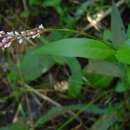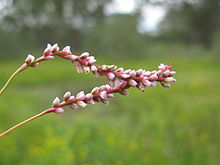ar
الأسماء في صفحات التنقل


Nile and Mediterranean regions.
Old World mainly tropical.
Persicaria decipiens, commonly known as slender knotweed, is a species of flowering plant native to Australia and Asia.[2]
Persicaria decipiens is a trailing plant whose stems grow horizontally at first but become more vertical with time,[3] reaching 30 cm (1 ft) high. Its narrow elliptic to lanceolate (spear-shaped) leaves are 5–12 cm (2–4.5 in) long and 0.5–1.3 cm (0.20–0.51 in) across.[2] The slender pink flower spikes appear from November to June, with a peak in February.[3] Cylindrical in shape, they are not stiff and tend to bend over.[2] The plant tends to die back in winter and regenerate after water.[3]
Persicaria decipiens was among the plants collected by Joseph Banks and Daniel Solander on 5 May 1770 at Botany Bay during the first voyage of Captain James Cook.[4] Prolific Scottish botanist Robert Brown described the species as Polygonum decipiens in his 1810 work Prodromus Florae Novae Hollandiae et Insulae Van Diemen.[5] It was given its current name by Karen Wilson in 1988 as the broadly defined genus Polygonum was split into smaller genera.[4] Common names include slender knotweed, willow weed and snake root.[6]
P. decipiens is found in water and wet soil. It is found across Africa and the Mediterranean,[6] through southwestern Asia, Malesia and all states of Australia, as well as Norfolk Island, New Zealand and New Caledonia.[2] It has become naturalised in Madagascar.[6]
Likely pollinators of its flowers are insects, including honeybees, native bees, flies, wasps and small butterflies.[3]
Persicaria decipiens is not cultivated but is eaten locally in times of famine in Africa.[6]
Persicaria decipiens, commonly known as slender knotweed, is a species of flowering plant native to Australia and Asia.
Persicaria decipiens is a trailing plant whose stems grow horizontally at first but become more vertical with time, reaching 30 cm (1 ft) high. Its narrow elliptic to lanceolate (spear-shaped) leaves are 5–12 cm (2–4.5 in) long and 0.5–1.3 cm (0.20–0.51 in) across. The slender pink flower spikes appear from November to June, with a peak in February. Cylindrical in shape, they are not stiff and tend to bend over. The plant tends to die back in winter and regenerate after water.
Persicaria decipiens was among the plants collected by Joseph Banks and Daniel Solander on 5 May 1770 at Botany Bay during the first voyage of Captain James Cook. Prolific Scottish botanist Robert Brown described the species as Polygonum decipiens in his 1810 work Prodromus Florae Novae Hollandiae et Insulae Van Diemen. It was given its current name by Karen Wilson in 1988 as the broadly defined genus Polygonum was split into smaller genera. Common names include slender knotweed, willow weed and snake root.
 Flowerhead
Flowerhead P. decipiens is found in water and wet soil. It is found across Africa and the Mediterranean, through southwestern Asia, Malesia and all states of Australia, as well as Norfolk Island, New Zealand and New Caledonia. It has become naturalised in Madagascar.
Likely pollinators of its flowers are insects, including honeybees, native bees, flies, wasps and small butterflies.
Persicaria decipiens is not cultivated but is eaten locally in times of famine in Africa.
Persicaria decipiens là một loài thực vật có hoa trong họ Rau răm. Loài này được (R.Br.) K.L.Wilson mô tả khoa học đầu tiên năm 1988.[1]
Persicaria decipiens là một loài thực vật có hoa trong họ Rau răm. Loài này được (R.Br.) K.L.Wilson mô tả khoa học đầu tiên năm 1988.
Persicaria decipiens (R.Br.) K.L.Wilson, 1988
СинонимыPersicaria decipiens (лат.) — вид травянистых растений рода Персикария (Persicaria) семейства Гречишные (Polygonaceae), встречается от Австралии до Азии[2]. Ранее вид относили к роду Горец, как Polygonum decipiens.
Стебель Persicaria decipiens поначалу стелющийся и растущий горизонтально, со временем становится восходящий, достигает до 30 см в высоту.[3] Листья узкие эллиптические либо ланцетные, 5,0—12,0 см длиной и 0,5—1,3 см шириной[2].
Цветёт в ноябре — июне, с основным периодом цветения в феврале.[3] Цветки мелкие розовые, собраны в колосовидные кисти с поникающие верхушкой.[2]
Растение отмирает в засушливый период и регенерирует с появлением воды.[3]
Образцы Persicaria decipiens были впервые собраны 5 мая 1770 года Джозефом Бэнксом и Даниэлем Соландером в Ботаническом заливе во время первого путешествия Джеймса Кука.[4] Шотландский ботаник Роберт Браун описал вид как Polygonum decipiens в своей работе 1810 года Prodromus Florae Novae Hollandiae et Insulae Van Diemen.[5] Современное название виду было дано Карен Уилсон в 1988 году после того как большой род Polygonum был разделён на несколько родов.[4]
Произрастает от Африки и Средиземного побережья через юго-западную Азию, Малайзию до Австралии, Новой Зеландии и Новой Каледонии.[2] Натурализован на Мадагаскаре.[6]
Persicaria decipiens растёт в воде и на сырых местах.
Опыляется насекомыми, включая пчёл, мух, ос и мелких бабочек.[3]
Persicaria decipiens не культивируется, но используется в пищу в Африке в случае голода.[6]
|deadlink= (справка) Persicaria decipiens (лат.) — вид травянистых растений рода Персикария (Persicaria) семейства Гречишные (Polygonaceae), встречается от Австралии до Азии. Ранее вид относили к роду Горец, как Polygonum decipiens.